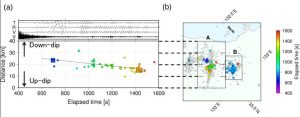Ryo Kurihara, Kazushige Obara, Akiko Takeo, Takuto Maeda
Geophysical research letters, 45 (2018)
DOI:10.1002/2017GL076779
Abstract
Deep low-frequency tremor triggered by teleseismic surface waves is concentrated in several locations along the ambient tremor source region in the Nankai subduction zone, southwest Japan. We systematically investigated triggered tremor in northern Kii and western Shikoku, at 71 teleseismic earthquakes by applying a matched filter technique. We detected 9 and 17 events of triggered tremor in northern Kii and western Shikoku, respectively. In addition, we observed tremor migration episodes, whose directions were always along-dip. In northern Kii, seven episodes showed downward migration at a speed of 5–20 km/hr. In western Shikoku, six episodes migrated at a speed of 10–100 km/hr, in which five episodes showed upward migration. Migration of the triggered tremor suggests that dynamic stress perturbation from distant earthquakes may trigger propagating creep events caused by fluid.



